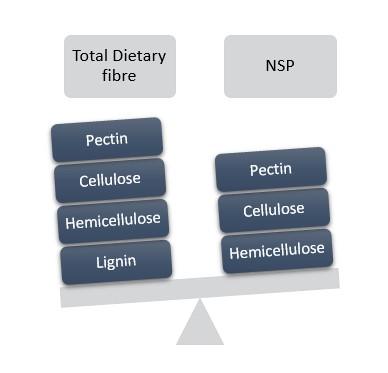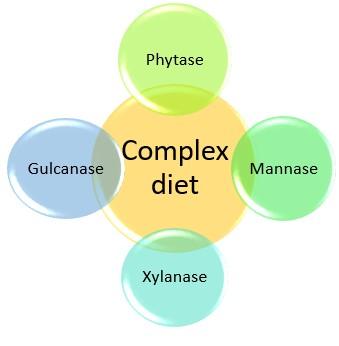The genetic potential of modern broiler strains can only be exploited by focusing on their changed nutritional requirements. Feed is the most important aspect of poultry production which is primarily based on corn and soy, but the cost of feed ingredients for poultry diets continues to rise due to increased demand and decreased availability. This has resulted in rise in conventional feed formulations, making it important to understand the composition of alternative feed ingredients. The cell wall of these feed alternatives is found to be rich in polysaccharides other than starch. Non starch polysaccharides (NSPs) are polymeric carbohydrate fractions excluding starch and free sugars. They include cellulose, hemi-cellulose and pectin. Commercial broiler diets contain around 10–12% total NSP which are non-digestible for monogastric animals. NSP and lignin together account for digestible fibres which increases the requirement to measure NSP levels accounted during feed formulation in order to accurately estimate the dietary fibre received by the animal. According to the nutritional value they can be classified into water-soluble (beta-glucans and pectin) and water-insoluble (cellulose) fractions. It is well-established that dietary NSP regulates digestion and modulates gastrointestinal health in poultry, directly influencing birds’ performance and litter quality. NSPs has high molecular weight that enhances its water-holding capacity leading to increased viscosity, increased excreta moisture, increased endogenous secretions, decreased litter quality, impaired diffusion and connective transport of lipase, oil and bile salt micelles within gastro-intestinal contents along with entrapping nutrients. Soluble NSPs acts as anti-nutritive substance in the body as it undergoes rapid fermentation in intestine and act as source of energy for anaerobic microbes. It helps to propagate harmful pathogen like Clostridium perfringens which causes various diseases in animals and poultry. Generally, fibre content is considered to be an issue only in diets containing viscous grains with high soluble NSP level, such as wheat and barley which contain approximately 10–12% and 17–20% NSP out of which approximately19% and 29% are water soluble NSPs, respectively.

Traditionally, only the anti-nutritive effects of NSP have been considered, but a recent report has highlighted the positive impact of NSP on broiler gastrointestinal health and performance, namely through its role as a source of substrates that are beneficial for intestinal bacteria through selective fermentation, resulting in production of short chain fatty acids, which provide a source of energy, and reduced ability for pathogenic bacteria to proliferate. It is found that the microbiota preferentially ferments soluble NSP over insoluble NSP as a result, overwhelming a naive microbiota with soluble NSP can compromise its ability and need to ferment insoluble NSP. However, exposure to these dietary polymers or oligosaccharides derived from them in young birds can prime the microbiota to become more adept at utilising more complex NSP later in life. This reconfirms that young chick require a minimum soluble NSP level in order to optimise early soluble NSP fermentation, which then influences the fermentation of total NSP at a later growing stage. It has also been reported that diets high in insoluble NSP is very effective in preventing the onset of cannibalism in laying hen.
NSP-degrading enzymes are commonly applied to poultry diets, primarily as a tool to eliminate viscosity effects. According to a recent global survey, the penetration rate of NSP enzymes in poultry diets has been reported to exceed 70%, suggesting a general acceptance of the feed industry for these enzymes regardless of cereal type. The effect of exogenous enzymes is inexorably linked to their substrates and the subsequent impact on the inherent nutritional value of the feed to which they are added. Endo-b-1-4-xylanases and b-1-3, 1-4-glucanases have been used commercially in diets that are based on wheat and barley for approximately 20 years in the ‘viscous grain’ market and has acquired the maximum market of broiler feed industries. These work on viscosity theory and the ‘cage’ effect theory. In essence, the nutritional quality of a feed ingredient is a function of the concentration and digestibility of the nutrients within, the dilution of those with compounds of no nutritional value (such as cellulose) and the exacerbation by those of a negative nutritive value (such as trypsin inhibitors). When enzymes are added to the feed ingredients, they may be considered to either enhance the digestibility of nutrients or to reduce the inimical effects of anti-nutritional factors. It is logical to assume that enzymes have been shown to reduce variability of the energy value of an ingredient also, the improvement in energy value will be greater for low metabolizable energy ingredients than for ingredients with an inherently higher metabolizable energy content. A common opinion is to relate the amount of the substrate offered by a given dietary raw material as the criterion for selection of an enzyme solution. One of the common approaches is to relate the ‘complexity’ of diet. Complexity in this context refers to the presence of a range of different NSP substrates resulting from using alternative feedstuffs in diet formulation. A research study suggested that the phytate is more closely associated with fibre in wheat than in maize, that the effects of xylanase on Phosphorus retention and synergy with phytase will be more apparent in wheat-based diets. Many researchers tend to support this, as they found that xylanase was capable of improving the retention of dietary P. Similarly, maize-based diets demonstrated that a carbohydrase and protease cocktail could be successfully combined with phytase to additively enhance nutrient retention in a nutritionally marginal diet. In this trial it was noted that phytase improved the retention of P and Ca and the carbohydrase – protease cocktail was effective in improving the retention of energy, DM and N, and when the two enzyme systems were combined there was an additive effect. It seems therefore that in wheat-based diets, xylanase may have a synergistic relationship with phytase due to the tertiary phytate –fibre –mineral complexes but in maize the effects are likely to be additive or sub-additive. The results from another study depicted improved total tract digestibility of NSP as a result of supplemental complex enzymes in both corn-soybean meal or corn-canola meal-based diets. The improved NSP digestibility coincided with improved ileal digestibility of protein in the corn-soy diet while depressing the protein digestibility in corn-canola based diet which was reflected in an improved growth rate and efficiency in corn-soy diet with no effect in corn-canola meal-based diets.

The use of strategic combinations of enzymes can be extremely effective in improving the nutritional value of diets based on wheat and maize and allows the formulation of very-low-cost diets, thus improving profitability of poultry entrepreneurs. The enzymes which work in such conditions best are the complex enzymes supplemented with probiotics.
Rossari Biotech has developed an enzyme solution called Maxizyme EX which is apt for the current challenges. A cocktail enzyme supplemented with probiotics that helps in reducing feed cost and helps leveraging the use of unconventional feeds along with the conventional feeds.






